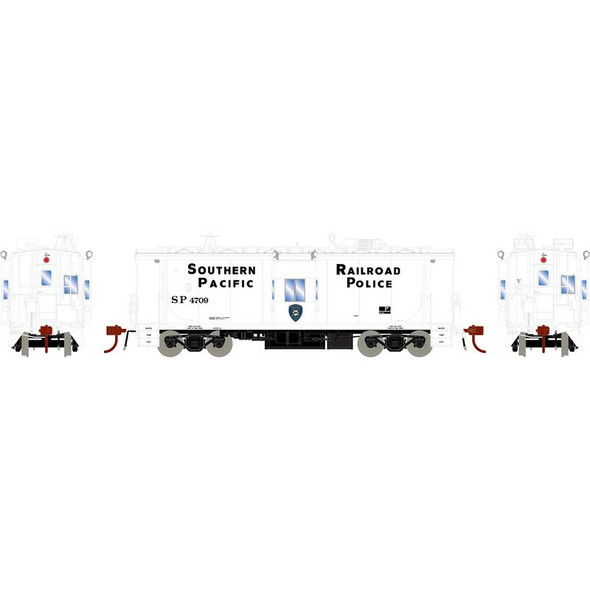Description
NOTE: Image is representative of the paint scheme only. See listing for actual car number.
The Ultimate Detail With The Best Genesis Features.
International Car Co. began specializing in caboose production as early as 1941. When the railroads entered the 1960s, many needed to replace their aging, in some cases home shop built, cabooses. International Car responded with a product that could be tailored to each railroad’s specific needs. Using quality components and modern engineering, ICC became a leading name within the industry.
Sharing ICC's commitment to quality and modern techniques, Athearn has not only recreated these iconic cars, but reinvented the quintessential features a Genesis caboose should have.
DCC lighting as a base standard with the option for sound will add a whole new dimension to operating sessions. Protect reverse moves and simulate train brakes, begins to scratch the surface to the new dimension of realism.
UP SERIES FEATURES:
- Air whistle (Functions in DCC)
Although cabooses are rarely used in their traditional role anymore, UP and many other railroads retain some for various uses, including as “Shoving Platforms” on locals and switch jobs. Some local and switching duties include long periods of shoving a cut of cars long distances. Since some freight cars are difficult or unsafe for crew members to ride during a shoving move, some railroads retained cabooses to give the crew a better and safer way of protecting reverse movements over long distances.
ICC CABOOSE FEATURES:
- Better than brass detail™ including roadname and road number specific detail Laser-Sharp Painting and Printing
- Interior seating for the addition of crew figures.
- Flush Window Glazing
- Wire-form Grab Irons
- Caboose trucks with animated rotating bearing or static friction bearing caps
- Axle Generator Details
- Body-Mounted McHenry® scale knuckle-spring Couplers
- Fully-assembled and ready-to-run out of the box
- Accurately painted and printed for prototypical realism
- Highly-detailed, injection-molded body
- Separate wireform grab irons, etched metal coupler platforms
- Coupler lift bars, trainline hoses, brake hoses, and hardware
- Full underframe detail: air brake reservoir, control valve, and brake cylinder with plumbing and brake rod details
- Machined metal wheels with RP25 contours operate on all popular brands of track
- Weighted for optimum performance
- Window packaging for easy viewing, plus interior plastic blister safely holds the model for convenient storage
- Multiple road numbers
- Minimum radius: 18”
LED LIGHT EQUIPPED FEATURES:
- LED lighting for long life and reliable operation
- On-board DCC Decoder by NCE
- Operates in DCC and Analog (DC) with lighting Functions Controllable in DCC
- Various classes will feature single or dual roof markers, or end-mount marker lights, per prototype and/or era (not all cars have marker lights)
- LED Interior Lights
- All functions NMRA compatible in DCC mode
SOUND EQUIPPED MODELS ALSO FEATURE:
- Soundtraxx Tsunami SoundCar decoder w/ included sounds:
- Air horn or conductor’s whistle as appropriate
- Clickety-clack with optional wheel flat spot sounds
- Brake set/release sounds including retainers and brake squeal
- ”Big Hole” emergency brake application sound
- Handbrake tie-down/release
- Adjustable flange squeal
- Supports Advanced Consisting in DCC
- Full DCC functions available when operated in DCC mode
- All functions NMRA compatible in DCC mode
PROTOTYPE INFO:
Perhaps one of the most recognizable icons of American railroading, the caboose completed the train. Cabooses provided shelter for the rear end crew. From the cupola or bay windows, the crew could keep a lookout for shifting loads, damaged equipment, and overheating axles, this was long required for switching and shunting. As rail cars became larger in the late 1950s and early 1960s, there was a real need for cabooses to have greater visibility for the crew. In the extended-vision or wide-vision caboose, the sides of the cupola project beyond the side of the car body. This model was introduced by the International Car Company and saw service on most U.S. railroads. The expanded cupola allowed the crew to see past the top of the taller cars that began to appear after World War II, and also increased the roominess of the cupola area.
Details
Store Location: |
P# 107 / Aisle 6D |
Scale: |
HO Scale |
Road Name: |
Union Pacific (SP) |
Version: |
w/ Lights |
Road Number: |
4747 |










